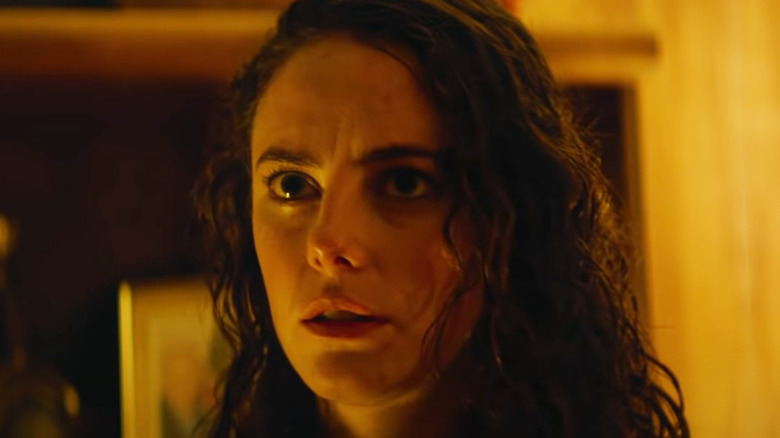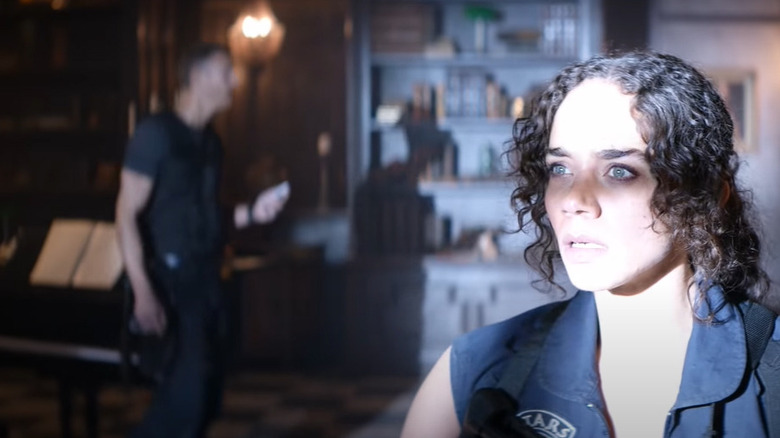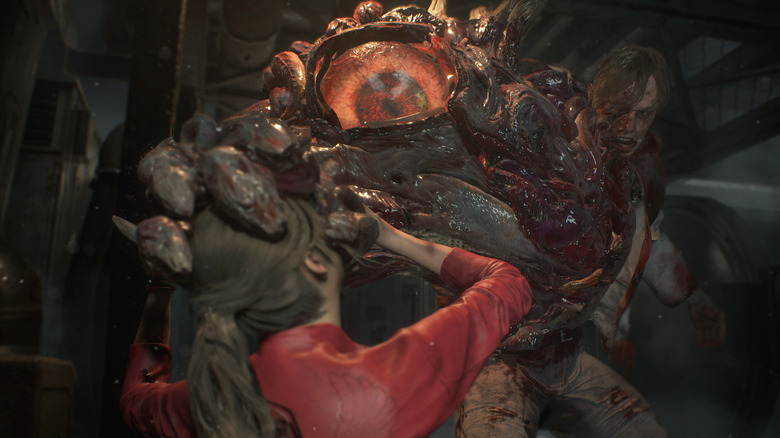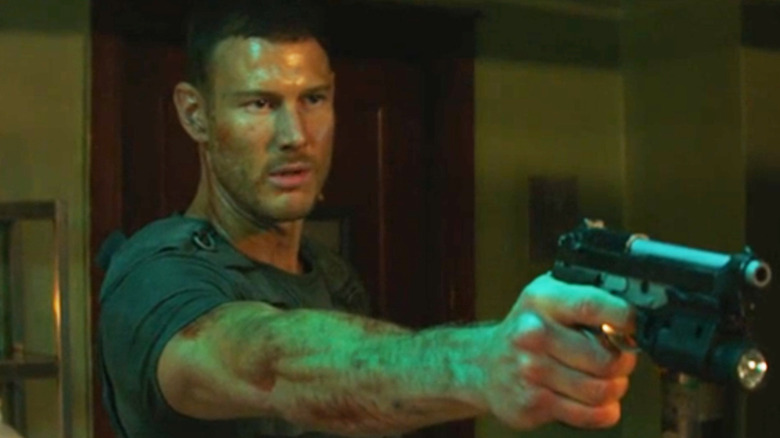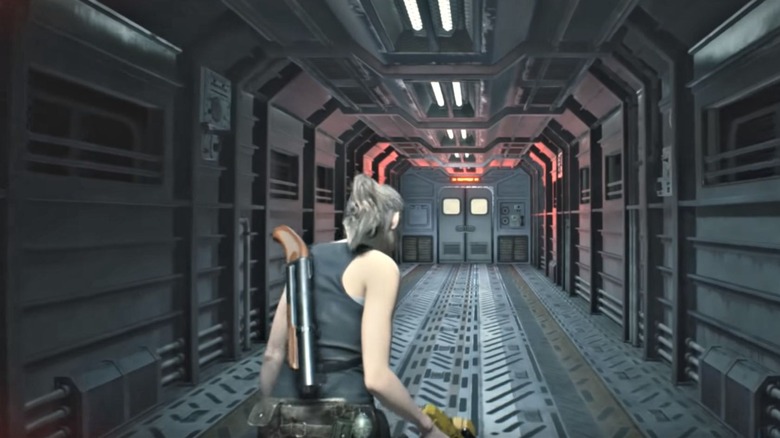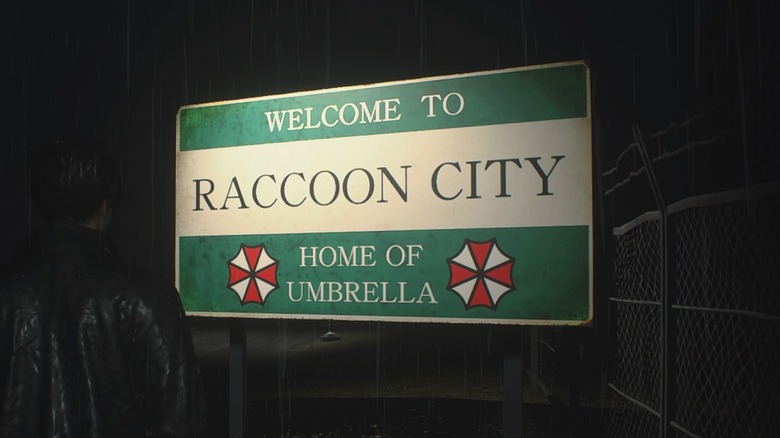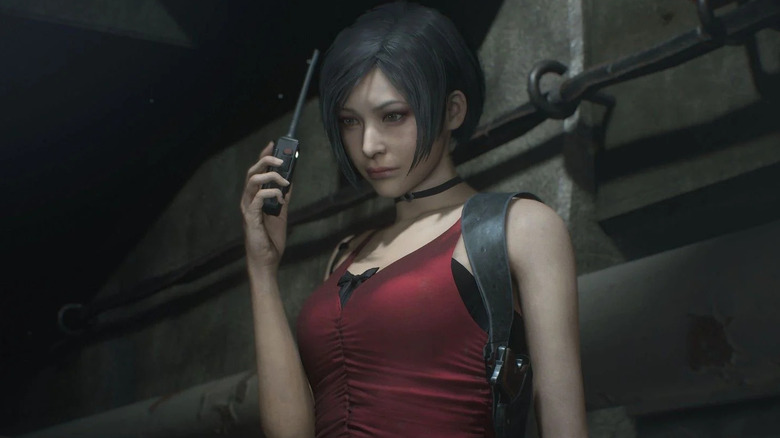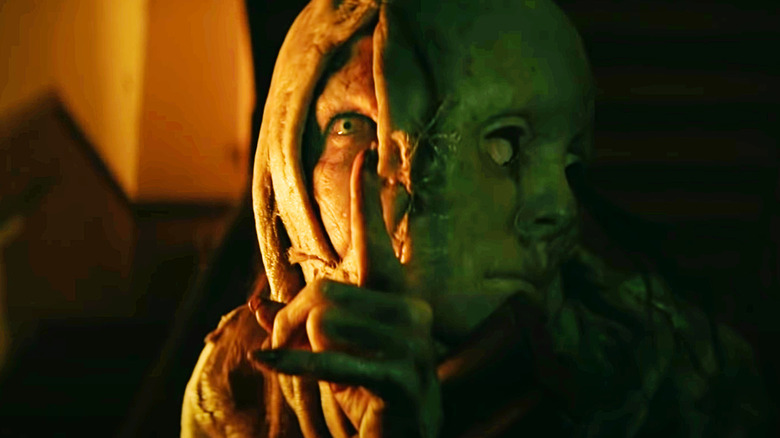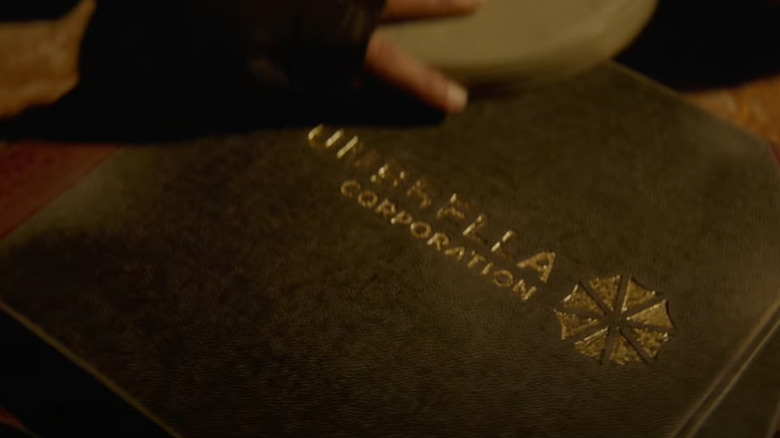The Ending Of Resident Evil: Welcome To Raccoon City Explained
The "Resident Evil" film saga gets a reboot with 2021's "Resident Evil: Welcome to Raccoon City." Skewing more closely to Capcom's original video games than the previous film series helmed by Paul W.S. Anderson does, this new spin on the Umbrella Corporation's ghastly experiments with bio-organic weapons takes players back to the beginning. We revisit Spencer Mansion from the original 1996 video game and its 2002 remake, as well as the streets of Raccoon City, as seen in 1998's "Resident Evil 2" and its own remake, released in 2019.
In the games, the "Raccoon City Destruction Incident" takes place in 1998, a timeframe to which the new movie adheres. This leads to moments of major 1990s nostalgia: Characters are seen listening to period-accurate music, marveling at the technological majesty of a Palm Pilot, and playing highly pixelated games of Snake on their monochromatic cell phones. "Resident Evil: Welcome to Raccoon City" is not a one-to-one copy of the source material, however — there's plenty here to keep even the most die-hard fans guessing. Characters who survive the original games don't necessarily make it out of the movie alive, and some villains are radical departures from their video game counterparts.
As a result, the ending of "Resident Evil: Welcome to Raccoon City" is simultaneously familiar and surprising to fans of the series. We're here to examine how it all shakes out, how it compares to the games, and what viewers should expect from a prospective sequel. Be warned: There are many SPOILERS ahead!
Resident Evil 1 and 2, remixed
The setting and story of "Resident Evil" and its first sequel are the stuff of legend to video game fans. The first game's mad monster party at the Spencer Mansion has already been adapted multiple times, from the game's 2002 remake to the 2007 on-rails shooter "Resident Evil: The Umbrella Chronicles." Similarly, the Raccoon City scenario (particularly the Raccoon Police Department setting), originally from "Resident Evil 2," is reused in 1999's "Resident Evil 3: Nemesis," the 2004 online co-op game "Resident Evil Outbreak: File 2," and, of course, the 2019 remake of "Resident Evil 2."
In the original games, the Spencer Mansion incident takes place in July 1998, with the chaos spilling out into the city two months later in September. "Resident Evil: Welcome to Raccoon City" merges these timelines, with the S.T.A.R.S. team led by Albert Wesker (Tom Hopper) going out to the Arklay mountains just before all hell breaks loose in the city. Claire Redfield and Leon S. Kennedy (Kaya Scodelario and Avan Jogia) go from the RPD building to the Raccoon City Orphanage, where they take an underground transport to the Spencer Mansion. There, they meet up with Chris Redfield and Jill Valentine (Robbie Amell and Hannah John-Kamen), the only survivors from Wesker's team, as well as Sherry Birkin (Holly De Barros), a young survivor they pick up along the way. From there, this new party escapes using an underground train evocative of the one from "Resident Evil 2." They fight one last creature before finally reaching safety — and the end credits.
The final monster
"Resident Evil: Welcome to Raccoon City" opens with the brother-sister duo of Chris and Claire Redfield as children in the Raccoon City Orphanage. Claire is visited by Lisa Trevor, a tragic monster whose backstory is unexplored in this movie. Unlike in the 2002 remake of the original "Resident Evil," however, Lisa is not a raging monster, but a scared little girl who, despite her ghastly visage, only wants to be Claire's friend. The true villain of the intro and, indeed, the whole film, is Dr. William Birkin (Neal McDonough), who uses the orphanage as a source of fresh meat for testing his viral concoctions. Lisa Trevor is implied to be one of his victims, but it's unclear how she roams the halls without being detected, or if Birkin even knows she's hiding in the orphanage.
As in "Resident Evil 2," Birkin is shot by an agent looking to secure a sample of the G-Virus. He survives by injecting himself with the experimental serum and transforming into a monster. His first form is taken down by Chris and Claire's well-placed shotgun slugs and a point-blank handgun headshot. Like any classic "Resident Evil" final boss, however, he returns in an even more mutated state. He nearly kills the Redfield siblings before Leon shows up with a rocket launcher (he says he found it in first class) and takes him out for good with a missile to the face. This is a nod to the video games, where many final bosses are traditionally taken down with some sort of rocket launcher. Ironically, though, in "Resident Evil 2," Dr. Birkin is not finished by a rocket. That honor goes to the Tyrant boss, who does not appear in "Resident Evil: Welcome to Raccoon City."
Wesker's divergent destiny
One of the biggest divergences from the games in "Resident Evil: Welcome to Raccoon City" comes in the form of Albert Wesker, leader of the doomed S.T.A.R.S. team sent to investigate the Spencer Mansion. In the game, he is a double agent who has been working for the Umbrella Corporation all along, helping to create their bio-organic weapons. He brings the S.T.A.R.S. team to the mansion in order to test the combat effectiveness of Umbrella's monsters.
In the movie, he has no loyalty to Umbrella, yet he still betrays his team. This time, it's out of financial desperation and a desire to leave Raccoon City, a corporate town that would be seen as dying even if the entire population wasn't turning into flesh-eating zombies. Early on, he receives a message on his pager telling him that Raccoon City is doomed. He is given a Palm Pilot with a map of the mansion and instructions to retrieve a sample of the G-Virus. This puts him on a crash course with Dr. William Birkin, who refuses to allow anyone to steal his unholy magnum opus.
Ultimately, Wesker murders Birkin and his wife before being fatally shot by Jill Valentine. Yes, instead of HUNK, the "fourth survivor" of the games, it's Wesker who shoots Birkin, and thus indirectly creates the G-Type monster. This is Wesker's final appearance in the film, until the post-credits scene.
The train escape
As in "Resident Evil 2," "Resident Evil: Welcome to Raccoon City" ends with the heroes and young Sherry Birkin on an Umbrella cargo train, leaving the city. This time, however, they're accompanied by Jill Valentine and Chris Redfield. In the original "Resident Evil," they escape via helicopter. Furthermore, in that game, S.T.A.R.S. pilot Brad Vickers rescues them from the roof of the mansion after throwing down the rocket launcher they use to defeat the first Tyrant. He is ultimately killed by Nemesis in "Resident Evil 3" (or a swarm of zombies, in its 2020 remake). In the movie, however, Brad doesn't make it past the mansion: He's ambushed by zombies while waiting for Wesker's team. Presumably overtaken by the T-Virus infection, he flies his helicopter into the mansion and dies in a massive explosion that nearly kills Jill and Wesker.
The train escape scenario isn't new to "Resident Evil" movies. The very first film, 2002's "Resident Evil," also features a train sequence, similarly designed to look like the one from "Resident Evil 2." Instead of being pursued by a G-Type, the 2002 movie's Alice (Milla Jovovich) and her allies are ambushed by an enhanced Licker creature. The classic rocket launcher coup de grâce is also absent in this version.
The fate of Raccoon City
Whether we're talking about the original games or Paul W.S. Anderson's films, the fate of Raccoon City is always bleak. In the games and 2004's "Resident Evil: Apocalypse," the city is wiped off the map by a missile strike, which contains the outbreak at a terrible cost. In "Resident Evil: Welcome to Raccoon City," the destruction of Raccoon City is portrayed somewhat differently. Rather than a tactical strike from outside the city limits, Raccoon City is essentially made to self-destruct through an underground detonation of some sort.
Apparently, Umbrella has had the entire city rigged to implode in the event of an outbreak, as a fail-safe system to contain any prospective infection. While some fans might be upset to see this different version of Raccoon City's destruction, it's worth noting that "Resident Evil: Apocalypse," while often ridiculed by gamers, does feature a faithful recreation of the missile strike shown in "Resident Evil 3." As such, it makes sense for the new movie to try something different.
Raccoon City's size is often debated. In the games, it's originally described as something of a quiet mountain town, with a population of just 100,000. But "Resident Evil 3" and the "Resident Evil Outbreak" games feature bustling city streets, an intricate underground subway system, and even a huge zoo with elephants, lions, and alligators, all of which seems a little conspicuous for such a small town. In "Resident Evil: Welcome to Raccoon City," however, the metropolis is portrayed as smaller, and thus more in line with its depiction in the first two games.
Wesker and Ada's story
After "Resident Evil: Welcome to Raccoon City" ends, a brief scene interrupts the credits, showing the return of Albert Wesker. No, he didn't survive being shot to death by Jill Valentine — he's been revived by the mysterious benefactor who ordered him to steal Umbrella's secrets. This person reveals herself to be none other than Ada Wong, the fan-favorite spy who made her debut appearance in "Resident Evil 2." She explains that she brought Wesker back to life, and when he complains about his eyes feeling sensitive to light, she hands him a pair of sunglasses and explains it's a side effect of the process used to revive him.
In the games, Wesker is almost never seen without his iconic sunglasses. Spotlighting the moment he receives them, as well as the mysterious serum, from Ada makes "Resident Evil: Welcome to Raccoon City" something of an origin story for this new take on one of the most popular villains in video game history. It's also worth noting that this Wesker and Ada occupy roles that are the opposite of the ones they hold in the games. There, Ada works for Wesker during the Raccoon City Incident, as shown in the "Death's Door" scenario of 2007's "Resident Evil: The Umbrella Chronicles." By the time the events of 2005's "Resident Evil 4" roll around, Ada is ostensibly aligned with Wesker, but secretly working with a still-unknown employer. In "Resident Evil: Welcome to Raccoon City," Wesker is basically a regular cop Ada introduces to a new world of espionage and intrigue.
Multiple unanswered questions
In the wake of Raccoon City's destruction, William Birkin's death, and Albert Wesker's resurrection, unanswered questions emerge. Firstly, does Lisa Trevor survive? In the game, she's nigh invincible, only dying for good when the mansion explodes around her. In the film, she shows off her physical strength when she tears a Licker apart in physical combat. Thus, she and her video game counterpart clearly have physical traits in common. Much of her game-bound backstory doesn't appear in the film, however. Will fans learn more in a subsequent film?
Secondly, who is Ada Wong working for? In both the games and "Resident Evil: Welcome to Raccoon City," Ada Wong is a mysterious agent with a penchant for spy games. She only makes a brief cameo in the film, but it's a sure bet she'll play a key role in a sequel, if the box office fates allow it.
Thirdly, how much does Chief Irons know about Umbrella? In the games, Brian Irons, the RPD's chief of police, is an outright villain who murders the mayor's daughter and nearly kills Sherry Birkin. In the movie, he seems to know more than others do about Umbrella's dastardly deeds, but his more overtly evil traits are absent. As a result, he's not a villain — in fact, he even brings Claire and Leon to the Raccoon City Orphanage and tells them how to get to Spencer Mansion before getting attacked and killed by a Licker. He's likely in on Umbrella's plot to some degree, but whether or not that qualifies him as an outright bad guy is open to debate.
Finally, just how close are Jill and Wesker? It's implied Jill has romantic feelings for Wesker, much to Chris' chagrin. It's unclear how much Wesker reciprocates those feelings, but they don't appear to be a proper couple. In the likely event they reunite in a future sequel, there's definitely unfinished business between them ... especially since their relationship ends with Jill fatally shooting Wesker.
Sequel possibilities
Traditionally, each game in the "Resident Evil" saga tells its own story, set within a wider, interconnected world. Sometimes, characters and storylines are dropped for years before being picked up again. For example, Sherry Birkin from 1998's "Resident Evil 2" doesn't make another proper, canonical appearance until 2012's "Resident Evil 6," where she appears as one of the main playable characters. Likewise, Rebecca Chambers, save for non-canonical appearances in the "Mercenaries" minigames, vanishes after appearing in 2002's "Resident Evil Zero," a prequel to the original game, before finally returning in 2017's "Resident Evil: Vendetta."
In "Resident Evil: Welcome to Raccoon City," the story wraps up in a reasonably airtight fashion, meaning the filmmakers have their options open when it comes to how to approach a sequel. Teasing the Ashford twins might be more than just an Easter egg: A second movie could adapt portions of 2000's "Resident Evil — Code: Veronica," which takes Chris and Claire to an Antarctic base where they fight the Ashfords and a powered-up Wesker. In the games' canon, Jill's next key appearance following the destruction of Raccoon City occurs in "Resident Evil 5," where she is brainwashed by Wesker to fight against her old allies. Leon next appears in the beloved "Resident Evil 4." Though it's tonally different from the prior games, it wouldn't be surprising to see some variation of that entry's "Leon in Spain" premise form the basis of a future "Resident Evil" movie.
While the Umbrella Corporation is the main antagonist of the film (and most "Resident Evil" projects), it's mostly absent from "Resident Evil: Welcome to Raccoon City," as they're said to have abandoned the city by the time the movie begins. However, the film's ending suggests they will continue to be the villains of future projects. If so, Ozwell Spencer, the founder of Umbrella (who is mentioned by name in the film) will likely make an appearance. As he has a close relationship with Albert Wesker in the games, this new film series could do something interesting with their particular dynamic.
